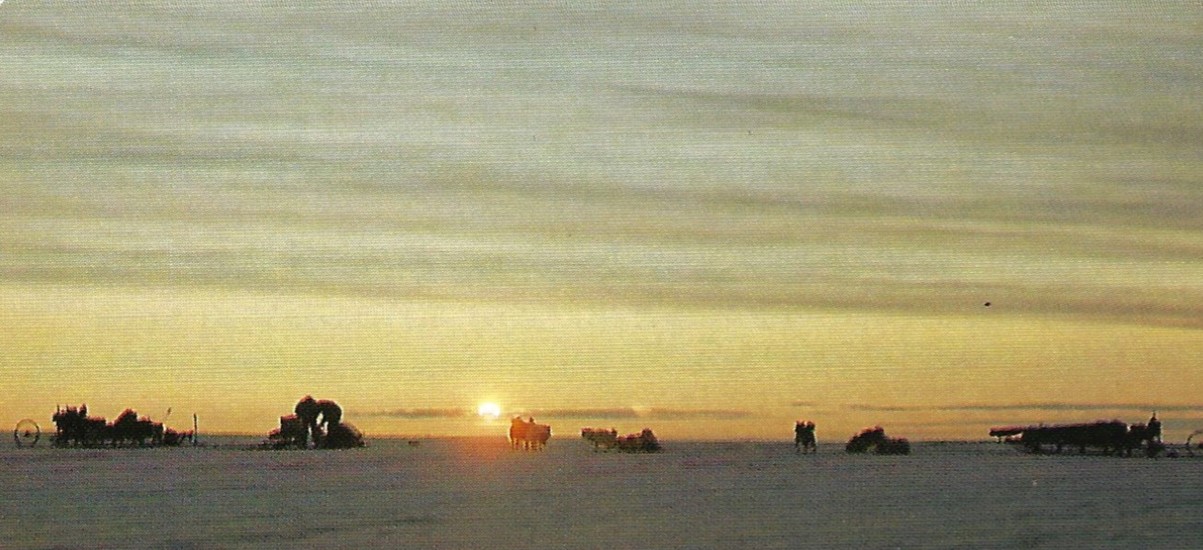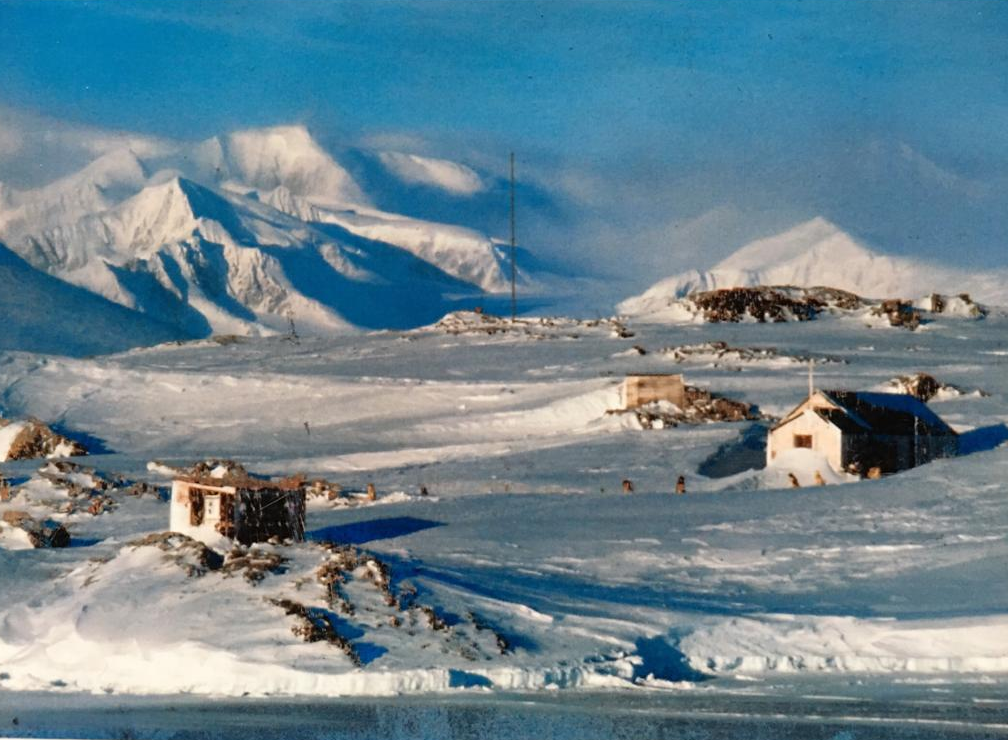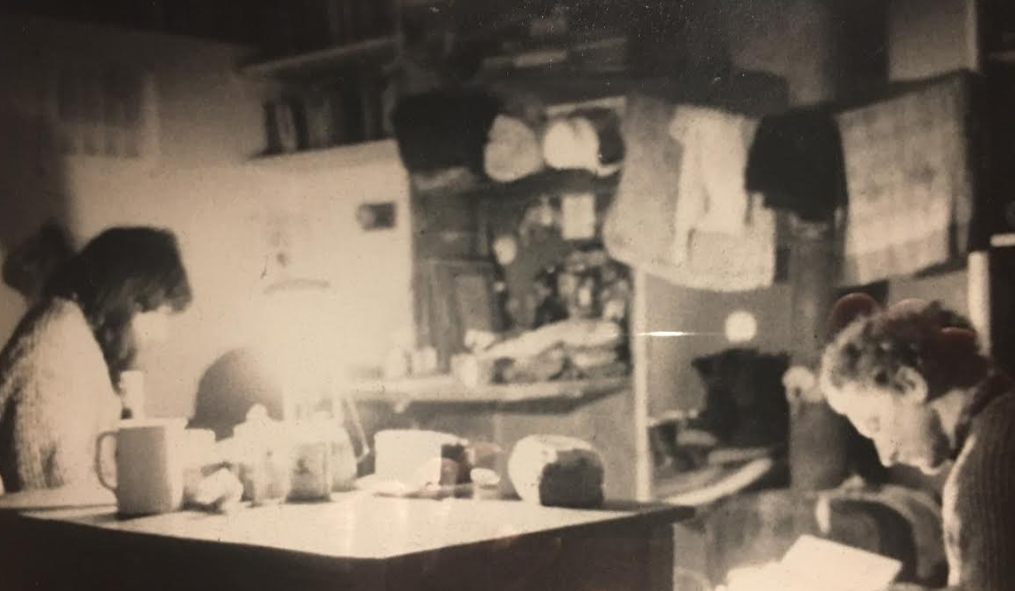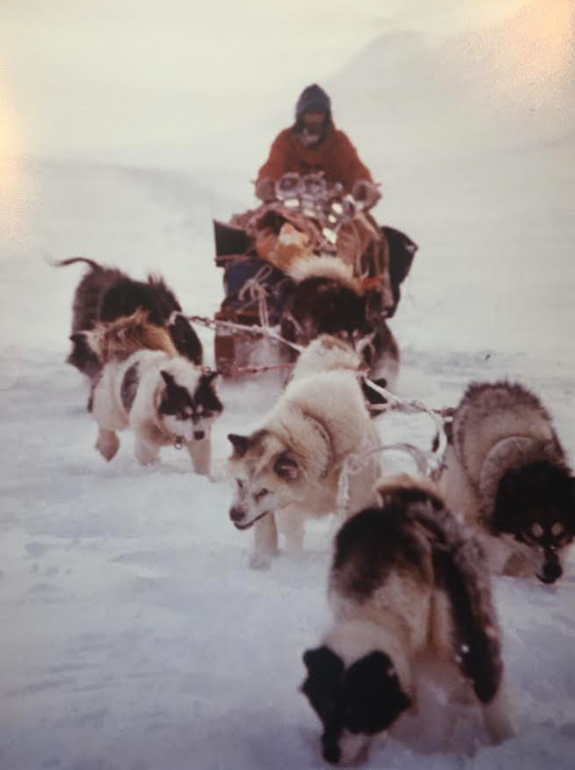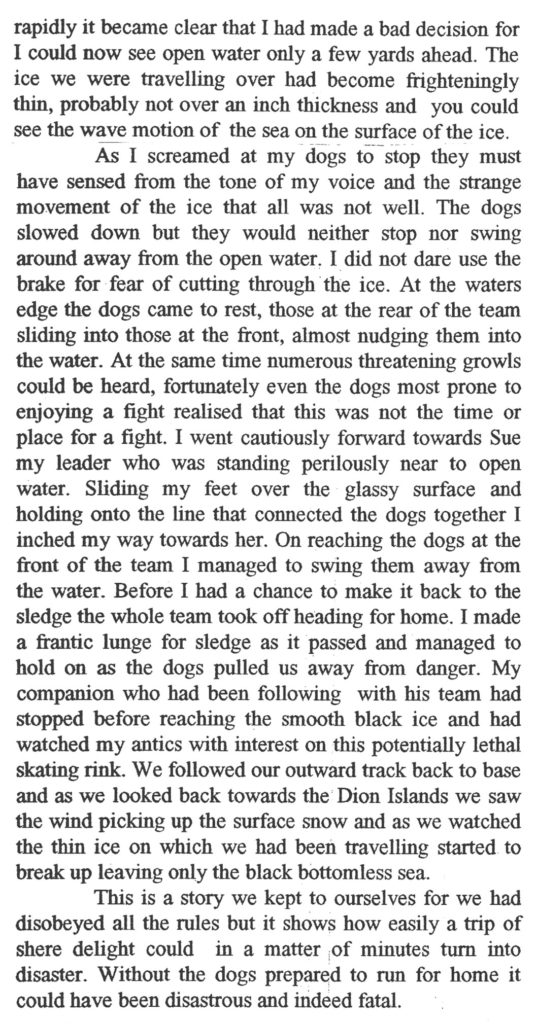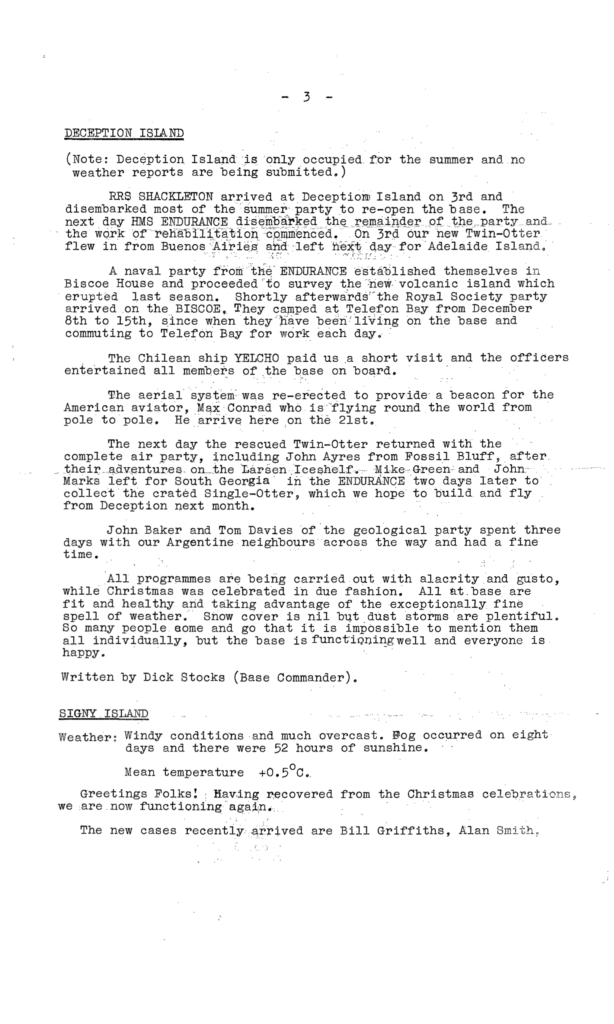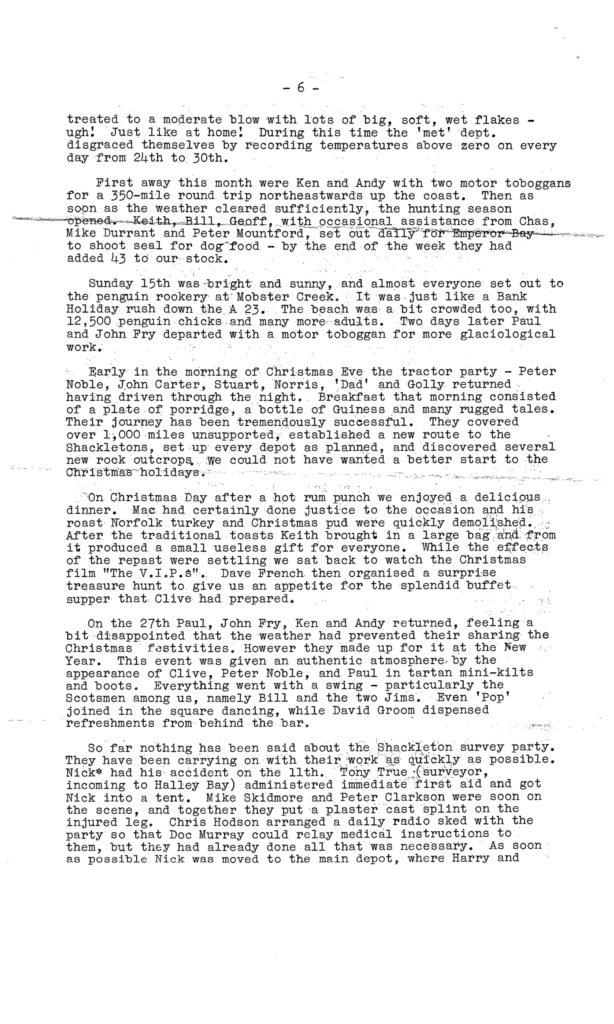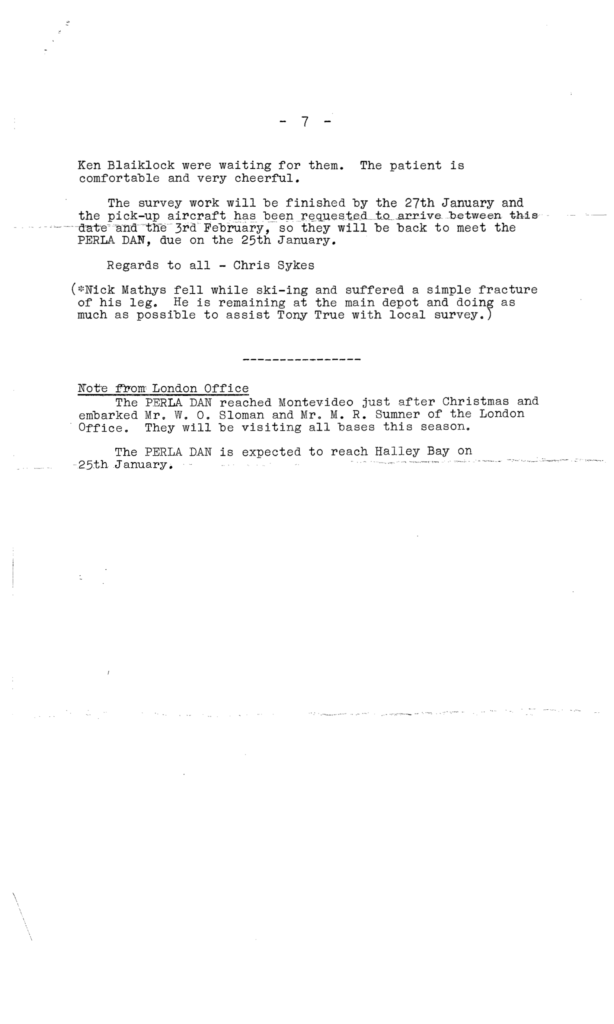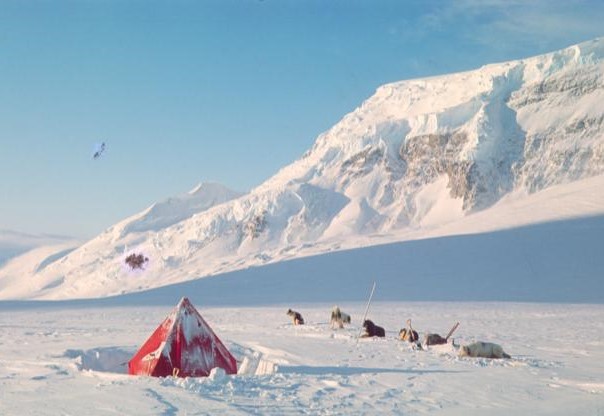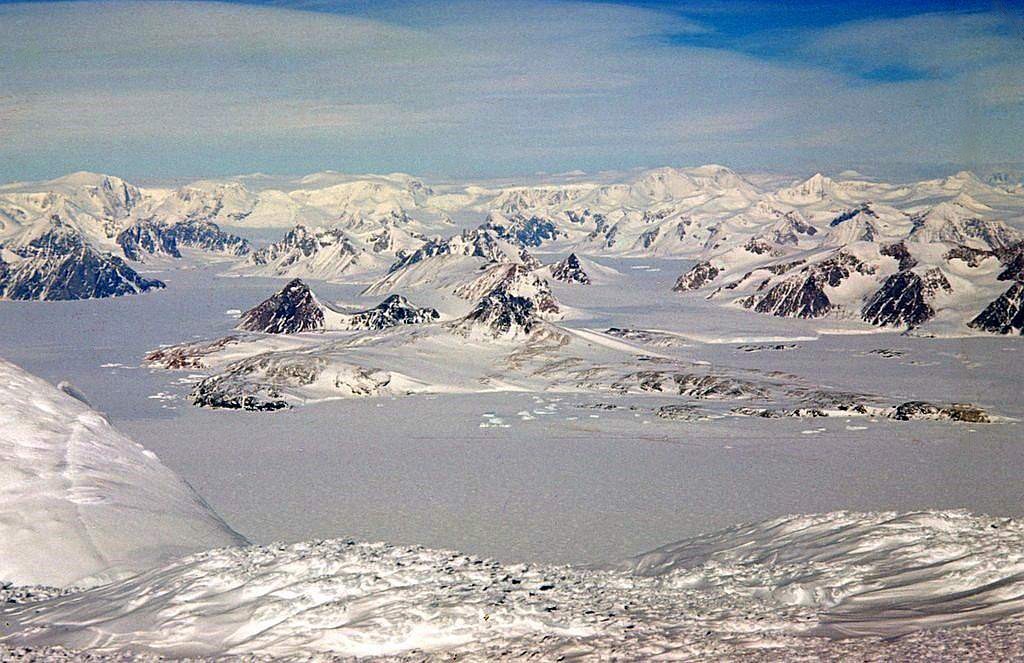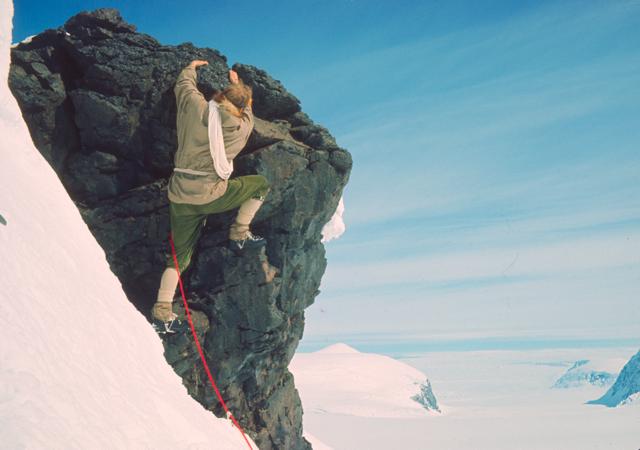The Spartans (continued)
During 1961 the team had run on Centre Trace and I retained this for the first half of the year. Over the winter, however, l converted the team to Fan Trace. The dogs reacted well to the change and the increased freedom it carried, and the fights became less frequent.
The first journey of the year was a two week training run up Northeast Glacier during the latter part of April and early May. The trip was made with Ben Hodges and the Moomins and Ivor Morgan and the objects were to acquaint ourselves with the dogs and sledging methods On closer acquaintance, and well away from Base, varying personalities began to emerge; the undisputed sovereignty of Steve, Ruth’s jealousy and her possessive nature, the excitability of Iota and solidarity of Nu. Epsilon proved a reliable leader but had a frustrated preference for following tracks. Athos was paired with Steve, a position which he retained until the end of the year. The two became the greatest of friends. Athos regarded Steve with the greatest respect and at the same time imbibed some of the latter’s philosophical wisdom and placid good nature. Faerie proved a nervous and excitable handful, frequently calling forth greater reserves of patience than I possessed.
From the 8th of August until the 4th of September all the teams took part in a survey scheme in the Mount Wilcox area. Unfortunately the work was completed from a single static camp and the dogs had long periods of inactivity. In spite of temperatures which went as low as minus 30° F all the dogs except Nu put on weight.
The dogs were still running on Centre Trace at this stage and were paired as follows.

On the return trip to Base I noted that Iota showed signs of stiffness in the back legs, possibly the result of prolonged inactivity followed by a fast surface. Although I made frequent stops for him to rest he arrived at Base quite exhausted. At Base he appeared to make partial recovery though much of the stiffness remained.
September and October were spent in waiting for aircraft flights. The sea-ice was in good condition and with frequent nursing, the fitness of the team increased. It was at this period that I first began running the team on Fan. There was also an addition to the team in Angus, one of Dot’s litter born in March. As he was a long legged creature and very fast for a time I paired him with Nu moving Faerie back to run with Iota.
The running order for the Fan trace was ;–

Epsilon was considerably improved as a leader and no longer felt the magnetism of a set of tracks. I frequently used Ruth as an auxiliary leader. On the 21st October the Spartans and I were flown to Fossil Bluff for the Summer Survey Programme.
November and the early part of December were spent working with Brian Taylor on the Uranus Glacier. Once again the dogs did little load carrying and most of the work was with a light or empty sledge. At this time Iota’s back leg became more acute making it impossible for him to keep up with the team.
As I had received instructions to return to Adelaide to join the Larsen Shelf Ice party once the Biscoe arrived I handed the team over to Rodney Walker who was to continue working with Brian Taylor. The team remained in the Sound until the beginning of January when they were flown to Adelaide and I took them over again
While at Adelaide I obtained Faerie’s sister Brownie for inclusion in the team. Although she possessed some of the excitable nature of her sister, Brownie was a good and fast worker and I hoped that they would work as a pair.
Steve was getting on in years and arrangements were made to retire him to Deception. This was a timely move as was seen a few days after his arrival, when at Adelaide Epsilon usurped power and Steve was forced into subjection. I was very sad to see the grand old man cowed in this way and to save him further indignities I removed him from the team. To balance the loss of Steve I had the option of two of g being sent down from Deception, with these reinforcements I put Iota down.
Epsilon obviously felt uncertain of his newly acquired sovereignty and was continually asserting his Kingship over Angus and Athos. Until well into 1963 fights were frequent.
Several short trips were made on the Adelaide Piedmont in connection with the Navy’s Hydrographic Survey programme before the three Larsen teams, Giants, Vikings and Spartans were brought to Stonington at the end of February.
General Notes – 1963/64 Season
Once back at Base the two pups Oluf and Sven were added to the team. They were splendidly built dogs, only 7 months old and something of a handful. In nature they were diametrically opposed; Sven was an exuberant bouncy puppy while Oluf presented a shy, timid, almost cringing nature that was as difficult to explain as it was to deal with.
The first major journey was to lay a depot at Three slice Nunatak. I decided to leave the two pups behind for this trip. They were still unused to running and I felt that they would be more trouble than they were worth in crevassed areas.
The Giants and Spartans with Ron Tindall, Ralph Horne and myself left Base on April 6th intending to make a reconnaissance for the main depot party which would follow. The journey was a very hard one for the dogs with a combination of heavy loads, poor surfaces and low temperatures. Ron and I fed dogs on the basis of 1 block of Nutrican per day and an additional feed wherever possible. This was insufficient and they arrived back at Base lethargic and disinterested.

Early on the journey Epsilon received a bad gash on his right leg which in the cold temperatures refused to heal and it remained troublesome for two months after his return.
Winter-running around base was seriously affected by the poor condition of the sea-ice but on July 21st the Spartans again left base for the Bourgeois Fjord area. Oluf and Sven were running with them and I slightly modified the Fan separating the dogs into two fans, one of five with one of four behind. I moved Brownie forward to run slightly behind Ruth. The two bitches up in front provided a buffer between Epsilon and his arch enemies, Angus and Athos. Ruth seemed to tolerate Brownie whereas she detested Faerie. The running order for the team then was:-

Apart from a two day run across Neny Fjord during August and odd sealing trips around Base the dogs did little until their departure for the East Coast on September 4th.
During the latter part of the winter Nu had suffered a gradual decline exhibiting the same stiffness as his brother had done a year previously. After a long fast running day in the Traffic Circle he collapsed and I was obliged to put him down. Details of the 1100 miles covering the Larsen Project are recorded elsewhere.
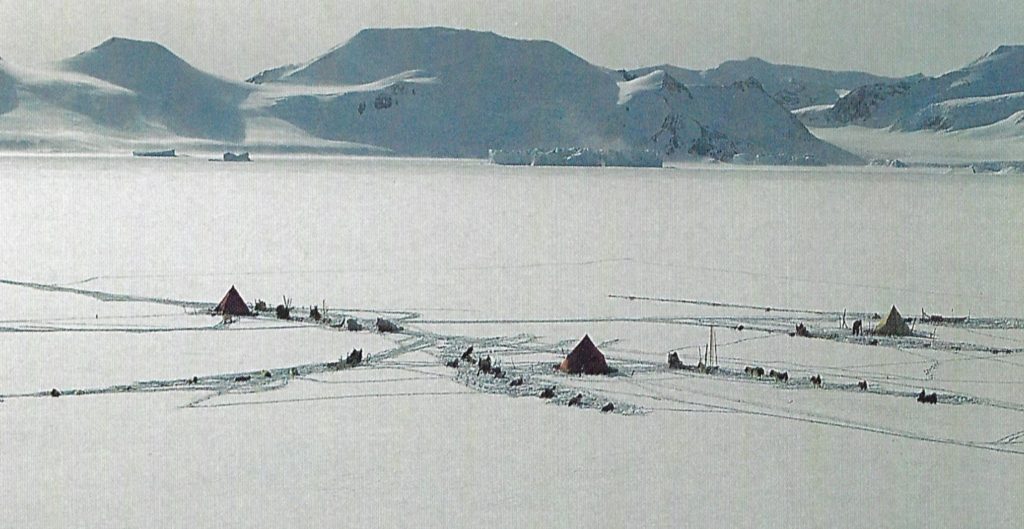
(Photo: Ian McMorrin)
The running order for the team remained the same throughout the year except that I lengthened the fan by the addition of another pennant which moved the whole team forward and gave the rear dogs, Oluf and Sven a little more freedom. The dogs worked excellently and apart from odd cuts suffered no injuries. Loads for the journey varied considerably. When working with the single team and Elsan combination they seldom dropped below 600 lbs and were frequently in the 800 lbs region. For a short period, Churchill Depot to Cape Disappointment the team pulled 1300 lbs fairly comfortably but it was flat!

The team spent 17 weeks in the field on a basic ration of 1:1:2 (4 blocks in 3 days) with additional double feeds when depots were reached. They suffered no marked deterioration in condition. On average the bitches gained 6 1bs while the dogs lost 7.
ILLNESS AND INJURY
Beyond the usual bites, which are only to be expected, the dogs have remained surprisingly free from both illness and injury. Perhaps the most important ailment was that which led to the partial paralysis of both Iota and Nu. Little can be said of this though it seems to have been a family complaint as Zeta, of the Admirals, had to be destroyed for the same reason in Sept 1962. The ailment manifested itself in the form of a slight stiffness which became gradually worse until the dog could no longer keep up with the team. His gait became wobbly and erratic. In the case of Iota’s pain, it seems to have been absent though Nu, who collapsed after a long, fast day seemed to be in considerable pain. Both dogs had to be destroyed.
Epsilon’s wound has been referred to. Faerie received a bad tear wound on her left shoulder. The wound was closed promptly with 4 stitches and within a day all but one were removed and the wound healed well. Ruth had chronic constipation and Athos suffered from frequent nosebleeds.
Litters
Faerie gave birth to a litter of nine on 22nd of March 1963, the sire is unknown. Five were dead on arrival and as she did not appear to be looking after the pups and in view of her excitable nature the remaining four were destroyed.
TABLE of JOURNEYS AND MILEAGES
Northeast Glacier. 52 miles in 16 days.
Wilcox Survey. 75 miles in 27 days.
(Team – Epsilon, Ruth, Steve,Nu, Athos, Iota and Faerie)
King George VI Sound. 400 miles in 76 days.
(Same team plus Angus)
Adelaide Island. 120 miles in 24 days.
3 Slice Nunatak Depot. 210 mile in 345
(Team – Epsilon, Ruth, Athos, Nu, Angus, Brownie and Faerie.
Bourgeois Fjord. 116 miles in 21 days.
Larsen Shelf Ice. 860 miles in 115 days.
Team – The same plus Oluf and Sven. 9 dogs.
Total – 831 miles in 313 days
Individual Comments
EPSILON is an intelligent leader and currently King Dog. He responds well to commands though he is capable of exhibiting a good deal of will at times. At such time patience and persistence are the only counters. He takes his social position seriously and frequently feels the need to assert his power. At present his main enemy is Angus and in the event of a free for all these two should be separated first. Of particular value is his skill and intuition in crevassed areas. He very seldom requires a second command and very often selects his own line always crossing at right angles. With so many young dogs in the team he sometimes feels the pace and I have made a point of controlling the speed of the team to suit him.
RUTH – the gangsters ‘Moll’. Epsilon’s right hand girl. An extremely possessive lass who’s agility is a constant wonder. In spite of her age she can keep up with the team on any surface. Her jealousy and complete possessiveness over Epsilon is a source of much amusement. She cannot stand Faerie though tolerates Brownie. Like any ‘Moll’ she is spoilt and expects a pat with her Nutrican in the field. In fact she will call you back should you forget
ATHOS – Possibly the most consistent worker in the team and the least noticed. He is not by nature belligerent though he always joins in a fight. He and Angus make a fine winning pair. He has been tried as a leader and with further training should respond well.
ANGUS – A splendid young worker but inclined to be ‘Bolshie’. He is the object of much of Epsilons terrorism and more often than not comes off second best. He is full of bouncy life and is sometimes known as ‘McPuke’.
FAERIE – A fast, neurotic, nymphomaniac lass who can be very trying on the patience. As a worker she is excellent and pulls her heart out. He flirtations are a source of disgust to all in the team except Oluf and Sven.
BROWNIE – an endearing bitch, a splendid worker and far less demanding than her sister.
OLAF and SVEN – are the two power houses of the team. Although they are both young they fit into the team well and can be relied upon on all surfaces. Their natures are very different. Olaf is shy and timid while Sven is boisterous and full of life. The origin of Olaf’s timidity is difficult to understand but with careful treatment and only moderate use of the ‘thumper’ he has thawed out considerably. As a worker he is unequalled. Sven is much easier to manage and is also a good worker though he tends to shy at crevasses. With time this should disappear.
Various
The running trace system being used at present is the modified BGLE Fan. The layout is as follows:-

The double fan system which I have used during 1963 avoids much of the tangling which occurs with the Single Fan. This is particularly so when young dogs are running at the back.
When moving as a following team I would remove the forward of their two 8 ft pennants.
When leading or travelling on fan surfaces the additional 8 feet increases the freedom and also the pleasure of the dogs. For securing the fan trace to the pennants I have found the large ‘Stubai’ karabiners effective.
When starting out in the morning I place the dogs onto the Fan in their running order, starting from the front. Once on they were given a short ‘schooling’ i.e. I made them lie down and keep still on pain of a clip from the ‘thumper’. I found that this greatly increased my control over the dogs.
b) Night trace system. I have used a wire night trace for both years. I find it effective though it has its failings. It is slower than the systems used by both the Giants and the Moomins. The fractious elements in the team decided me against using the fan trace as the night trace. Perhaps with patience it could be done. The night trace order I used was:
Oluf Sven Faerie Athos Brownie Angus Ruth Epsilon.
c) Commands. The commands I have used are:
When starting :“Right lads! WHEEEET”, followed by jubilant shouts to increase enthusiasm. i.e. “There we go, Pull away” etc.
To turn left “RRRRRRrrrrrrr”, rolling with the tongue.i.e. “RRRRrrrr Epsilon, good lad’
To turn Right, ” Auk! Auk!” twice. Short and sharp. i.e. “Auk Epsilon there we go”.
To stop “AHHHHHHNow” long and gentle and coinciding with a gentle pressure on the brake. i.e. “AHHHHNow… There we are lads”
In addition I have found it important to keep the dogs from becoming bored. At intervals throughout the day I would shout in a high falsetto. This caused the dogs to increase their pace and for a short period they would gallop enjoying the new spurt..
Little further need be said except good luck and good sledging.
Ian McMorrin – Stonington, GA – 1962 & 1963

